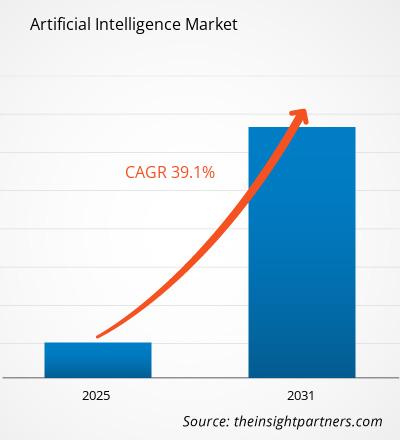2024 年人工智能市场规模为 1932.5 亿美元,预计到 2031 年将达到 17067.1 亿美元;预计 2025 年至 2031 年期间的复合年增长率为 37.8%。代理人工智能的蓬勃发展可能会在未来带来新的市场趋势。
人工智能市场分析
各行各业日益普及、政府举措和投资支持人工智能技术的应用以及对多模式人工智能的蓬勃发展的需求是推动全球人工智能市场扩张的重要因素。此外,对工业自动化解决方案的投资增加和代理人工智能的日益普及可能会推动未来对人工智能的需求。技术进步和机器学习、自然语言处理 (NLP) 和机器人流程自动化 (RPA) 等先进技术的集成;对生成性人工智能的需求;可解释人工智能 (XAI) 和人工智能驱动的网络安全解决方案的开发预计将在预测期内为市场创造机会。定制化人工智能解决方案需求激增、制造商专注于开发小型语言模型和开源技术进步以及研发活动的增加,也使全球人工智能市场受益。
人工智能市场概览
人工智能 (AI) 是多种技术的结合,使计算机能够执行各种高级操作,例如阅读、理解、翻译口头和书面语言、分析数据和提出建议。人工智能是当前计算创新的基础,为个人和企业创造价值。例如,光学字符识别 (OCR) 使用人工智能从照片和文档中提取文本和数据,将非结构化内容转换为可用于业务的结构化数据,并提供关键洞察。各行各业在各种应用中使用基于人工智能的系统和软件,包括语音识别、图像识别、翻译、预测建模、数据分析和网络安全。人工智能带来的显著优势包括全天候可用性、重复性任务自动化、更少的人为错误、更多更快的数据洞察、降低物理风险以及增强决策能力。
自定义此报告以满足您的要求
您将免费获得任何报告的定制,包括本报告的部分内容,或国家级分析、Excel 数据包,以及为初创企业和大学提供超值优惠和折扣
人工智能市场: 战略洞察

- 获取本报告的主要市场趋势。这个免费样本将包括数据分析,从市场趋势到估计和预测。
您将免费获得任何报告的定制,包括本报告的部分内容,或国家级分析、Excel 数据包,以及为初创企业和大学提供超值优惠和折扣
人工智能市场: 战略洞察

- 获取本报告的主要市场趋势。这个免费样本将包括数据分析,从市场趋势到估计和预测。
人工智能市场驱动力与机遇
支持人工智能应用的政府举措与投资
2025年1月,美国总统唐纳德·特朗普宣布将向私营部门投资高达5000亿美元,以加速美国人工智能基础设施的建设。该计划旨在增强美国在这一重要领域的竞争地位。这项声明的核心是由OpenAI、软银集团公司(9984.T)和甲骨文公司(ORCL.N)组建的一家名为Stargate的新合资企业。Stargate将专注于在美国建设先进的数据中心基础设施,预计将在全国范围内创造超过10万个新就业岗位。在股权合作伙伴联盟的支持下,Stargate已经获得了1000亿美元的初始投资,可立即部署。剩余的 4000 亿美元预计将在未来四年内作为分阶段资本配置战略的一部分进行投资。该计划在白宫正式启动,软银首席执行官孙正义、OpenAI 首席执行官 Sam Altman 和甲骨文董事长拉里·埃里森与特朗普一同出席,强调他们致力于将美国定位为人工智能领域的全球领导者。
包括埃森哲公司、Contents SpA、Aleph Alpha GmbH 和 Mistral AI 在内的科技和咨询公司正在投资人工智能技术。2023 年 6 月,埃森哲公司宣布投资 30 亿美元,以加速开发新的基于人工智能的解决方案。该公司计划利用这些解决方案帮助制造业、零售业和医疗保健等 19 个行业的企业。这些投资旨在开发和实施人工智能技术,应用于各种流程,以管理大量数据。因此,政府和私营机构的举措和投资都为人工智能的应用提供了支持。
生成式人工智能需求飙升
生成式人工智能使企业能够高效运作并保持领先于竞争对手。各国政府正在组织活动,以提高人们对生成式人工智能优势的认识。2025年4月,加州州长加文·纽瑟姆宣布了一项新的全州倡议,旨在将生成式人工智能技术整合到政府职能中。该倡议旨在利用人工智能优化交通管理,加强道路安全,并改善面向公众的服务,例如客户支持。纽瑟姆州长在一份官方声明中强调,这项努力的重点是加强而不是削弱政府服务,这强化了加州对创新驱动公共部门改进的承诺。
根据印孚瑟斯有限公司2023年12月发布的数据,全球各国都在投资生成式人工智能技术,以简化和自动化运营,增强产品开发,并优化客户体验。 2022 年至 2023 年间,法国和德国在 GenAI 方面的支出翻了一番,分别达到约 7.3 亿美元和 6.1 亿美元。在这两个国家,约有 50% 的企业已经部署了生成式人工智能或已将其应用于实际并实现了商业价值。英国、比荷卢三国和北欧约有 40% 的公司投资人工智能技术以改善业务运营。2023 年 12 月,英国超过比荷卢三国,位居第三,其支出可能会增加两倍或更多,达到约 5.1 亿美元。2023 年,北欧国家的公司在 GenAI 上的投资将是目前的 2.5 倍以上,总额超过 4.7 亿美元。因此,用于管理业务流程的生成式人工智能工具和模型的开发有望在全球人工智能市场创造未来的增长机会。
人工智能市场报告细分分析
有助于推导人工智能市场分析的关键细分市场是组件、组织规模和行业垂直领域。
- 基于组件,市场分为硬件、软件和服务。软件细分市场又细分为基于云端和本地部署。软件细分市场在 2024 年占据了市场主导地位。
- 按组织规模,全球人工智能市场分为大型企业和中小型企业。大型企业细分市场在 2024 年占据了市场主导地位。
- 按行业垂直领域,市场细分为汽车、医疗保健、制造、零售和电子商务、IT 和电信、BFSI 等。 2024 年,IT 和电信领域占据了市场主导地位。
按地域划分的人工智能市场份额分析
- 人工智能市场分为五大区域:北美、欧洲、亚太地区 (APAC)、中东和非洲 (MEA) 以及南美和中美。北美在 2024 年主导了人工智能市场。欧洲是全球人工智能市场的第二大贡献者,其次是亚太地区。
- 北美的人工智能市场分为美国、加拿大和墨西哥。北美是微软、谷歌和亚马逊等科技巨头的所在地,它们在人工智能研究、云平台和生成式人工智能方面投入了大量资金。2023 年,人工智能初创企业的风险投资资金达到 400 亿美元,推动了创新。美国国家人工智能计划和加拿大泛加拿大人工智能战略等政府举措支持研究和公共部门的采用。关键行业包括医疗保健(诊断)、金融(欺诈检测)和汽车(自动驾驶汽车)。在一流大学的支撑下,强大的人才库巩固了该地区的地位。然而,诸如加州《加州消费者隐私法》(CCPA)等监管碎片化以及人工智能人才的激烈竞争增加了成本。网络安全风险和围绕人工智能偏见的伦理担忧也构成挑战,要求企业优先考虑合规性和透明度,以维护消费者信任和市场主导地位。
人工智能市场
The Insight Partners 的分析师已详尽阐述了预测期内影响人工智能市场的区域趋势和因素。本节还讨论了北美、欧洲、亚太地区、中东和非洲以及南美和中美洲的人工智能市场细分和地域分布。
人工智能市场报告范围
| 报告属性 | 细节 |
|---|---|
| 市场规模 2024 | US$ 193.25 Billion |
| 市场规模 2031 | US$ 1,706.71 Billion |
| 全球复合年增长率 (2025 - 2031) | 37.8% |
| 历史数据 | 2021-2023 |
| 预测期 | 2025-2031 |
| 涵盖的领域 |
By 组件
|
| 覆盖地区和国家 | 北美
|
| 市场领导者和主要公司简介 |
|
人工智能市场参与者密度:了解其对商业动态的影响
人工智能市场正在快速增长,这得益于终端用户需求的不断增长,而这些需求又源于消费者偏好的不断变化、技术进步以及对产品优势的认知度不断提升等因素。随着需求的增长,企业正在扩展其产品线,不断创新以满足消费者需求,并抓住新兴趋势,从而进一步推动市场增长。

- 获取 人工智能市场 主要参与者概述
人工智能市场新闻和最新发展
人工智能市场的评估是通过收集一手和二手研究后的定性和定量数据进行的,这些数据包括重要的公司出版物、协会数据和数据库。人工智能市场的主要发展如下:
- IBM 在纽约市推出了 Watsonx AI Labs,这是一个全新的、以开发者为先的创新中心,旨在增强 AI 构建者的能力并加速 AI 的大规模采用。Watsonx AI Labs 将 IBM 的企业资源和专业知识与下一代 AI 开发者相结合,为企业构建突破性的 AI 应用程序。
(来源:IBM,新闻稿,2025 年 6 月)
- 埃森哲宣布,埃森哲风险投资公司已投资 Aaru,后者是 AI 驱动的预测引擎的创造者,该引擎可以模拟消费者行为和偏好,从而带来更强大的客户体验、新的增长机会和更快的上市速度。作为此次合作的一部分,埃森哲宋氏计划将 Lumen——Aaru 面向私营部门的旗舰模式——融入其人工智能产品和服务中,涵盖新产品开发、市场营销、客户战略和客户服务。
(来源:埃森哲,新闻稿,2025 年 3 月)
人工智能市场报告覆盖范围和可交付成果
《人工智能市场规模和预测(2021-2031)》对市场进行了详细的分析,涵盖以下领域:
- 涵盖范围内所有关键细分市场的全球、区域和国家/地区人工智能市场规模和预测
- 人工智能市场趋势,以及市场动态,例如驱动因素、限制因素和关键机遇
- 详细的 PEST 和 SWOT 分析
- 涵盖关键市场趋势、全球和区域框架、主要参与者、法规和最新市场发展
- 行业格局和竞争分析,涵盖市场集中度、热图分析、知名参与者和人工智能市场的最新发展
- 详细的公司简介
- 历史分析(2 年)、基准年、预测(7 年)及复合年增长率
- PEST和SWOT分析
- 市场规模、价值/数量 - 全球、区域、国家
- 行业和竞争格局
- Excel 数据集
近期报告
客户评价
购买理由
- 明智的决策
- 了解市场动态
- 竞争分析
- 客户洞察
- 市场预测
- 风险规避
- 战略规划
- 投资论证
- 识别新兴市场
- 优化营销策略
- 提升运营效率
- 顺应监管趋势




















 获取免费样品 - 人工智能市场
获取免费样品 - 人工智能市场